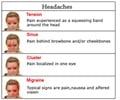
David Dodick, MD, professor of neurology at Mayo Clinic in Phoenix, explained that triptan medications used to treat migraine patients are designed to constrict blood vessels, which for centuries were believed to cause migraine.
"While migraine research has been massively underfunded and the disorder often is clinically dismissed as a 'headache,' its genetic and biological basis is increasingly coming into focus as the result of considerable scientific advances over the past two decades," said Dodick.
"Today we know that migraine is a largely inherited disorder characterized by physiological changes in the brain, and, if attacks occur with high frequency, structural alterations in the brain."
Migraine sufferers experience reduced quality of life as well as impaired physical, social and occupational functioning.
Dodick insists that advances in migraine knowledge have led to the development of promising new and selective compounds and therapies for both acute and preventive treatment of migraines.
Advertisement
The basis for preventive treatment is to understand that underlying risk factors for migraine can be modified or eliminated before migraine attacks become more frequent.
Advertisement
He claimed that controlling risk factors can help prevent episodic migraine patients from becoming chronic pain sufferers.
"Migraine risk factors can be treated effectively in the primary care setting, and we need to educate practitioners about what they can do to help prevent migraine in their patients," Dodick said.
"About 40 percent of migraine patients are candidates for preventive treatments but only 10 percent receive them. Doctors just want to treat the pain because they have little time to spend with patients to explore other options. They need to start thinking about the treatment of migraine in a disease model context, in much the same way as hypertension or diabetes," he said.
In his observation, Dodick, noted that obese people have a five-fold risk for developing migraine and depressed individuals have a three-fold higher risk. So treating these risk factors is an effective prevention strategy.
The American Academy of Neurology and the American Headache Society has announced new guidelines for migraine treatment in April,.
The guidelines support preventive treatments using a wide variety of medications from antidepressants to blood pressure lowering drugs to plant extracts.
"The new AAN guidelines illustrate that there are many treatments for which there is substantial evidence to support their safety and efficacy for the preventive treatment of migraine.
"Physicians should use the guidelines to individualize treatment, based on coexisting and comorbid conditions which may be present in their patients, with medications that have the highest level of evidence," said Dodick.
Acute treatments are taken when a migraine attack occurs, but preventive routine should be followed every day to prevent attacks or to lessen their severity and duration.
"Some studies have shown that that migraine attacks can be cut in half or more with preventive treatments," Dodick added.
Source-ANI













